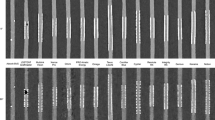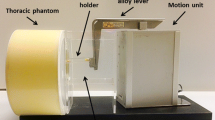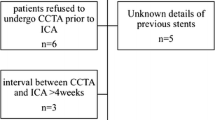Abstract
The aim of this study was to test a large sample of the latest coronary artery stents using four image reconstruction approaches with respect to lumen visualization, lumen attenuation, and image noise in dual-source multidetector row CT (DSCT) in vitro and to provide a CT catalogue of currently used coronary artery stents. Twenty-nine different coronary artery stents (19 steel, 6 cobalt-chromium, 2 tantalum, 1 iron, 1 magnesium) were examined in a coronary artery phantom (vessel diameter 3 mm, intravascular attenuation 250 HU, extravascular density −70 HU). Stents were imaged in axial orientation with standard parameters: 32 × 0.6 collimation, pitch 0.24, 400 mAs, 120 kV, rotation time 0.33 s. Image reconstructions were obtained with four different convolution kernels (soft, medium-soft, standard high-resolution, stent-dedicated). To evaluate visualization characteristics of the stent, the lumen diameter, intraluminal density, and noise were measured. The stent-dedicated kernel offered best average lumen visualization (54 ± 8.3%) and most realistic lumen attenuation (222 ± 44 HU) at the expense of increased noise (23.9 ± 1.9 HU) compared with standard CTA protocols (p < 0.001 for all). The magnesium stent showed the least artifacts with a lumen visibility of 90%. The majority of stents (79%) exhibited a lumen visibility of 50–59%. Less than half of the stent lumen was visible in only six stents. Stent lumen visibility largely varies depending on the stent type. Magnesium is by far more favorable a stent material with regard to CT imaging when compared with the more common materials steel, cobalt-chromium, or tantalum. The magnesium stent exhibits a lumen visibility of 90%, whereas the majority of the other stents exhibit a lumen visibility of 50–59%.



Similar content being viewed by others
References
Rosamond W, Flegal K, Furie K et al (2008) Heart disease and stroke statistics–2008 update: a report from the American Heart Association Statistics Committee and Stroke Statistics Subcommittee. Circulation 117:e25–e146
Moses JW, Leon MB, Popma JJ et al (2003) Sirolimus-eluting stents versus standard stents in patients with stenosis in a native coronary artery. N Engl J Med 349:1315–1323
Stone GW, Ellis SG, Cox DA et al (2004) A polymer-based, paclitaxel-eluting stent in patients with coronary artery disease. N Engl J Med 350:221–231
Remmel M, Hartmann F, Harland LC et al (2007) Rational use of drug-eluting stents: a comparison of different policies. Crit Pathw Cardiol 6:85–89
Maintz D, Juergens KU, Wichter T et al (2003) Imaging of coronary artery stents using multislice computed tomography: in vitro evaluation. Eur Radiol 13:830–835
Kruger S, Mahnken AH, Sinha AM et al (2003) Multislice spiral computed tomography for the detection of coronary stent restenosis and patency. Int J Cardiol 89:167–172
Ligabue G, Rossi R, Ratti C et al (2004) Noninvasive evaluation of coronary artery stents patency after PTCA: role of multislice computed tomography. Radiol Med (Torino) 108:128–137
Maintz D, Grude M, Fallenberg EM et al (2003) Assessment of coronary arterial stents by multislice-CT angiography. Acta Radiol 44:597–603
Mahnken AH, Buecker A, Wildberger JE et al (2004) Coronary artery stents in multislice computed tomography: in vitro artifact evaluation. Invest Radiol 39:27–33
Maintz D, Seifarth H, Flohr T et al (2003) Improved coronary artery stent visualization and in-stent stenosis detection using 16-slice computed-tomography and dedicated image reconstruction technique. Invest Radiol 38:790–795
Gilard M, Cornily JC, Rioufol G et al (2005) Noninvasive assessment of left main coronary stent patency with 16-slice computed tomography. Am J Cardiol 95:110–112
Hong C, Chrysant GS, Woodard PK et al (2004) Coronary artery stent patency assessed with in-stent contrast enhancement measured at multi-detector row CT angiography: initial experience. Radiology 233:286–291
Schuijf JD, Bax JJ, Jukema JW et al (2004) Feasibility of assessment of coronary stent patency using 16-slice computed tomography. Am J Cardiol 94:427–430
Seifarth H, Raupach R, Schaller S et al (2005) Assessment of coronary artery stents using 16-slice MDCT angiography: evaluation of a dedicated reconstruction kernel and a noise reduction filter. Eur Radiol 15:721–726
Das KM, El-Menyar AA, Salam AM et al (2007) Contrast-enhanced 64-section coronary multidetector CT angiography versus conventional coronary angiography for stent assessment. Radiology 245:424–432
Oncel D, Oncel G, Karaca M (2007) Coronary stent patency and in-stent restenosis: determination with 64-section multidetector CT coronary angiography–initial experience. Radiology 242:403–409
Rist C, von Ziegler F, Nikolaou K et al (2006) Assessment of coronary artery stent patency and restenosis using 64-slice computed tomography. Acad Radiol 13:1465–1473
Rixe J, Achenbach S, Ropers D et al (2006) Assessment of coronary artery stent restenosis by 64-slice multi-detector computed tomography. Eur Heart J 27:2567–2572
Schuijf JD, Pundziute G, Jukema JW et al (2007) Evaluation of patients with previous coronary stent implantation with 64-section CT. Radiology 245:416–423
Van Mieghem CA, Cademartiri F, Mollet NR et al (2006) Multislice spiral computed tomography for the evaluation of stent patency after left main coronary artery stenting: a comparison with conventional coronary angiography and intravascular ultrasound. Circulation 114:645–653
Maintz D, Seifarth H, Raupach R et al (2006) 64-slice multidetector coronary CT angiography: in vitro evaluation of 68 different stents. Eur Radiol 16:818–826
Erbel R, Di Mario C, Bartunek J et al (2007) Temporary scaffolding of coronary arteries with bioabsorbable magnesium stents: a prospective, non-randomised multicentre trial. Lancet 369:1869–1875
Seifarth H, Ozgun M, Raupach R et al (2006) 64- Versus 16-slice CT angiography for coronary artery stent assessment: in vitro experience. Invest Radiol 41:22–27
Carrabba N, Bamoshmoosh M, Carusi LM et al (2007) Usefulness of 64-slice multidetector computed tomography for detecting drug eluting in-stent restenosis. Am J Cardiol 100:1754–1758
Pugliese F, Weustink AC, Van Mieghem C et al (2007) Dual-source coronary computed tomography angiography for detecting in-stent restenosis. Heart
Acknowledgements
The authors would like to thank all companies for providing their stents for in vitro evaluation and for the required information on their products.
Author information
Authors and Affiliations
Corresponding author
Additional information
David Maintz and Matthias Burg contributed equally to this publication.
Rights and permissions
About this article
Cite this article
Maintz, D., Burg, M.C., Seifarth, H. et al. Update on multidetector coronary CT angiography of coronary stents: in vitro evaluation of 29 different stent types with dual-source CT. Eur Radiol 19, 42–49 (2009). https://doi.org/10.1007/s00330-008-1132-5
Received:
Accepted:
Published:
Issue Date:
DOI: https://doi.org/10.1007/s00330-008-1132-5




